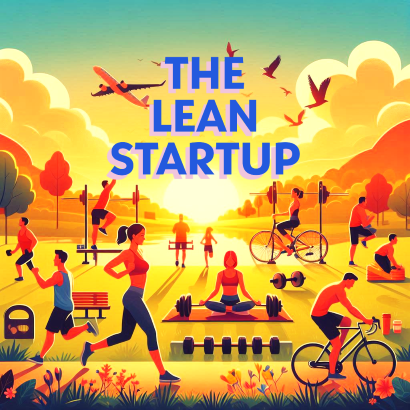15 Facts and Learnings from the "Lean Start-Up"

Online Chat Consultations
TRAINING | BUSINESS MENTORING | LIFE COACHING | PROJECT MENTORING | CONSULTATION
LIVE ONLINE IN PERSON COACHING
Chat / Call / Video Call
HOW DOES OUR ONLINE PAID CONSULTATION WORKS
YOU CAN CHOOSE CHAT / CALL / VIDEO CALL OPTIONS
1. CLICK ON THE LINK “CHECK YOUR BOOKING OPTIONS AND PRICING“.
2. YOU WILL BE REDIRECTD TO SECURE PAYPAL PAGE
3. CHOOSE AN OPTION FROM THE DROP DOWN MENU
4. CHOOSE NUMER OF SESSIONS (1 is selected by default)
5. MAKE SECURE PAYMENT VIA PAYPAL
6. DONE! WE WILL SEND IN YOUR MEETING DETAILS ON YOUR MAIL ID. YOU CAN CHOOSE A SLOT AND MEDIUM OF YOUR CHOICE.
Planning to Quit Drinking That 9 to 5 Poison!
Here are the top learnings from The Lean Startup by Eric Ries, a groundbreaking book that revolutionized how entrepreneurs and businesses approach innovation and product development
1. Build-Measure-Learn Feedback Loop
- At the heart of the Lean Startup methodology is the Build-Measure-Learn cycle:
- Build: Create a Minimum Viable Product (MVP) to test hypotheses.
- Measure: Collect feedback and data from customers.
- Learn: Analyze results to refine the product and make decisions.
- The goal is to shorten development cycles, minimize waste, and quickly determine what works.
2. The Minimum Viable Product (MVP)
- What is an MVP?: The simplest version of a product that can be launched to gather validated learning about customers with minimal effort.
- Avoid over-engineering. Focus on testing assumptions and solving core customer problems.
3. Validated Learning
- Instead of building a product based on assumptions, learn from real customer interactions and data.
- Use experiments to validate hypotheses about customer needs, behaviors, and market potential.
4. Pivot or Persevere
- Use data from the feedback loop to decide whether to:
- Persevere: Continue with the current strategy if the assumptions are validated.
- Pivot: Change direction or adopt a new strategy if assumptions are disproven.
- Pivots can involve changing the product, business model, target market, or distribution channels.
5. Measure What Matters
- Focus on actionable, measurable, and relevant metrics instead of vanity metrics.
- Actionable Metrics: Metrics tied to specific customer behaviors or product improvements.
- Vanity Metrics: Numbers that look impressive but provide no real insights (e.g., website hits without engagement).
6. Continuous Deployment
- Release small, incremental changes to the product frequently.
- Continuous deployment enables quicker feedback, faster iterations, and higher agility.
7. The “Five Whys”
- A problem-solving technique to identify root causes by asking “Why?” five times (or as many times as needed).
- Helps teams focus on fixing underlying systemic issues rather than superficial symptoms.
8. Lean Thinking Applied to Startups
- Borrowing from lean manufacturing principles:
- Eliminate waste by avoiding unnecessary features, processes, or development.
- Focus resources on delivering value to customers.
9. Start Small, Think Big, Scale Fast
- Test ideas on a small scale before committing significant resources.
- When validated, scale quickly and efficiently to meet demand.
10. Engage with Early Adopters
- Early adopters are more forgiving, provide valuable feedback, and help refine your product for the mainstream market.
- Use their insights to fine-tune your value proposition.
11. Innovation Accounting
- A method to track progress in conditions of extreme uncertainty.
- Focus on measuring progress against hypotheses and learning milestones, not traditional financial metrics early on.
12. “Startups Are Experiments”
- View every startup as an experiment designed to answer critical questions:
- Does the product solve a real problem?
- Will customers pay for it?
- Treat failures as opportunities to learn and refine.
13. Customer-Centric Development
- Develop products by involving customers early and often in the process.
- Create solutions based on customer feedback rather than internal assumptions or opinions.
14. Entrepreneurship Is Everywhere
- The Lean Startup methodology applies not only to startups but also to established organizations and internal corporate innovation projects.
- Intrapreneurship can benefit from the same principles of experimentation, MVPs, and feedback loops.
15. The Importance of Speed and Adaptability
- Success in a startup often depends on how quickly and effectively you can adapt to changing customer needs and market conditions.
- Be prepared to iterate rapidly while keeping your focus on the vision.
By emphasizing rapid experimentation, continuous learning, and customer-focused development, The Lean Startup provides a practical roadmap for turning ideas into successful products.
Would you like insights on applying these principles to a specific project or business? Contact Us @info@brainowconsulting.com

Syed Saif the founder and CEO of Brainow Consulting. He has over 24 Years of experience in Quality, Excellence, Innovation, Six Sigma, Lean, and Customer Services. He is a Certified Master Black Belt, ISO Lead Auditor, High Impact Trainer, Certified Business Excellence Assessor, Certified on Innovation Business Model Canvas, and holds a PG diploma in Customer Relationship Management. Syed Saif has trained thousands of people, from students to CEOs on various improvement methodologies and self help techniques, and has worked in various industries including BPO, Telecom, IT, Insurance, Manufacturing, and Healthcare. Prior to his full-time consulting role, he served as Vice President for a Leading Insurance Company and as National Head of Quality, Innovation, and Service for Corporate and Sales Functions. See our services page for more details on what we do and how can we help you and your organization.
